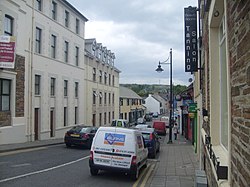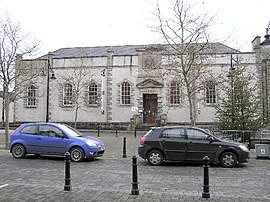Lifford: Difference between revisions
Created page with '{{Infobox town |name= Lifford |irish= Leifear |county=County Donegal |picture= Lifforddonegal.JPG |picture caption= |latitude= 54.835599 |longitude= -7.477913 |os grid ref=H3239…' |
No edit summary |
||
| Line 14: | Line 14: | ||
| web= www.donegalcoco.ie | | web= www.donegalcoco.ie | ||
}} | }} | ||
'''Lifford''' is the [[county town]] of [[County Donegal]]. It stands on the west bank of the [[River Foyle]] which at that point forms the border between | '''Lifford''' is the [[county town]] of [[County Donegal]]. It stands on the west bank of the [[River Foyle]] which at that point forms the border between the counties of Donegal in the Republic of Ireland and [[Tyrone]] in the United Kingdom. The Lifford Bridge across the Foyle links Lifford with [[Strabane]] in Tyrone. | ||
The town lies in the Finn Valley of East Donegal just below where the [[River Finn]] meets the [[River Mourne]] to create the [[River Foyle]]. | The town lies in the Finn Valley of East Donegal just below where the [[River Finn]] meets the [[River Mourne]] to create the [[River Foyle]]. | ||
Revision as of 12:06, 30 December 2010
| Lifford Irish: Leifear | |
| County Donegal | |
|---|---|

| |
| Location | |
| Grid reference: | H323984 |
| Location: | 54°50’8"N, 7°28’40"W |
| Data | |
| Population: | 1,448 (2006) |
| Dialling code: | 074 |
| Local Government | |
| Dáil constituency: |
Donegal South West |
Lifford is the county town of County Donegal. It stands on the west bank of the River Foyle which at that point forms the border between the counties of Donegal in the Republic of Ireland and Tyrone in the United Kingdom. The Lifford Bridge across the Foyle links Lifford with Strabane in Tyrone.
The town lies in the Finn Valley of East Donegal just below where the River Finn meets the River Mourne to create the River Foyle.
The town grew up around a castle established there by Manghus Ó Domhnaill, ruler of Tyrconnell (roughly today’s County Donegal), in the 16th century, and later became a British Army garrison town until the creation of the Irish Free State in 1922.
History
Lifford came into the possession of Sir Richard Hansard during the Plantation of Ulster in 1607. One of the conditions of his grant was that a ferry crossing be provided over the River Finn. This service continued until 1730 when the first bridge linking Lifford and Strabane was built.
In the 19th century a curious custom existed when the Assizes sat in Lifford and Omagh. If by the end of the Assizes a jury could not reach a unanimous verdict in a case, they were sent to the "verge" of the county to be dismissed.[1] In some of the cases of counties Donegal and Tyrone this would have been the middle of Lifford Bridge.
The present bridge was constructed by engineering company McAlpines in 1964, jointly funded by Donegal County Council and the old Tyrone County Council (the present Strabane District Council was only formed in the early 1970s. In 1968 during The Troubles, an attempt was made to blow the bridge up. However, it was only closed for a short time and today remains an important road link.
Places of Interest

Lifford has several noted buildings.
The Old Courthouse and Museum is located across from the HQ of Donegal County Council in the Diamond area of the town. The museum houses a permanent display of O'Donnell clan documents and artefacts, as well as minute books from various institutes in Donegal.
Cavanacor House on the outskirts of the town is the ancestral home of the 11th President of the United States of America, James Knox Polk. His great, great, great grandmother (Magdelene Tasker) was born here[2] in 1634, she later married Capt. Robert Bruce Pollock and emigrated to the USA. King James II dined at Cavanacor House on his way to the Siege of Derry in 1689.[2]
The Prior Endowed School was built in 1880 to cater for local Protestant children with monies bequeathed by Miss Eleanor Prior from Ballindrait. The Prior school closed in 1972, being amalgamated with the Royal School in Raphoe to create the "Royal & Prior Comprehensive School".[3] The school and grounds were first taken over by the then Irish Department of Posts & Telegraphs, and later (from 1974) by the Irish Defence Forces for use as a military barracks. It is currently occupied by ‘A’ Company, 28 Infantry Battalion of the Irish Army.[4]
References
- ↑ The Second Part of the Institutes of the Laws of England, Page 547
- ↑ 2.0 2.1 ©Searc.ie. "Donegal County.com & Dún na nGall.com - Cavanacor House". Dun-na-ngall.com. http://www.dun-na-ngall.com/cav.html. Retrieved 2010-05-14.
- ↑ "Royal and Prior Comprehensive School, Raphoe". Royalandprior.ie. http://www.royalandprior.ie/history.php. Retrieved 2010-05-14.
- ↑ "Lifford Military Post". Finn Valley Post. http://www.finnvalleypost.com/2008/10/15/lifford-barracks-to-shut/. Retrieved 2008-11-11.